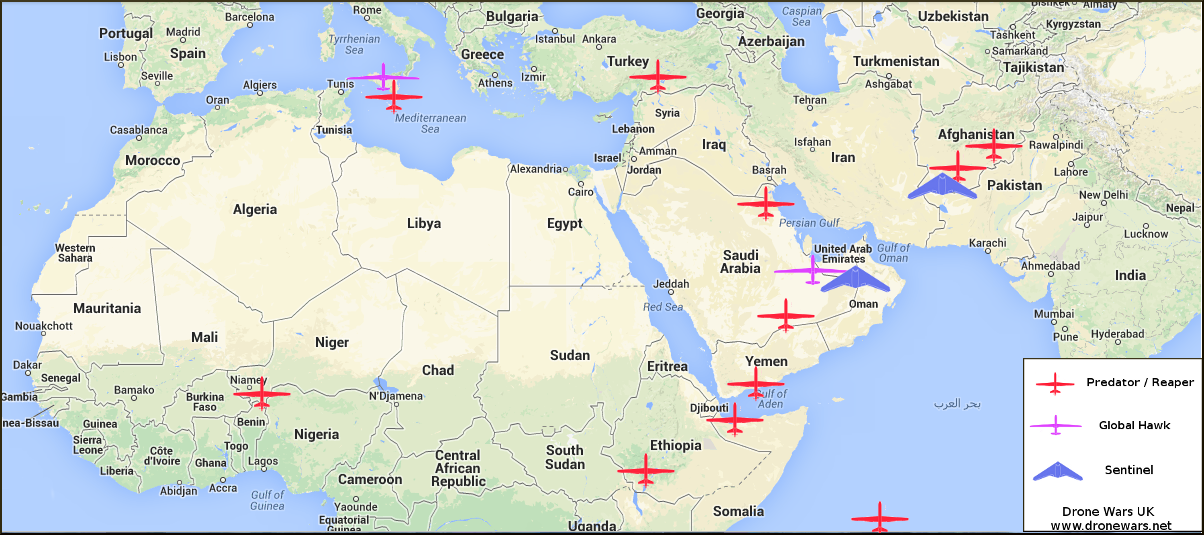One of the armed Reapers operated by the UK Royal Air Force, were over Afghanistan, now over Iraq and Syria.
---
Approximate position of Reaper/Predator bases in region with greatest concentration now on Iraq-Syria. Note other drones are deployed: high altitude Global Hawks and high altitude, stealthy Sentinels. Map courtesy of http://dronewars.net/2014/05/07/analysis-where-are-british-reaper-drones-heading-after-afghanistan/ which also lists the drone bases.
---
Several Royal Australian Air Force (RAAF) personnel are now being trained in the US to operate Reaper armed drones. This only became public in the last few days. From just a few Australians in training Australia may ramp up to a squadron sized capability of three to five Reapers over the next few years.
Reaper drones are more technically known as unmanned aerial vehicles (UAVs) and by militaries as remotely piloted aircraft (RPAs).
Australia has operated unarmed 1,150 kg Heron drones in Afghanistan for a few years in surveillance roles. Senior Australian officers have expressed interest inacquiring armed drones since at least 2012. The Australian Army has worked closely with US armed drones in Afghanistan since 2012, if not before. The war against Islamic State in Iraq has made training remote aircrew for drones and acquisition of armed drones themselves a high priority for the RAAF. It is also a high priority for the Australian Army who will most probably be unofficially fighting on the ground before 2016.
In a Media Release of February 23, 2015 Australian Parliamentary Secretary for Defence, Darren Chester, announced: “…that the Royal Australian Air Force (RAAF) has commenced training aircrew and support staff on [Reaper] operations in the United States.
Mr Chester said that the training program provides a cost effective method to increase the ADF’s understanding of complex [drone] operations and how this capability can be best used to protect Australian troops on future operations.
“Unmanned aerial systems are an advancing technology with a proven record of providing ‘eyes in the sky’ in the Middle East region,” Mr Chester said.
“It would be remiss of Australia not to continue to develop our knowledge of this technology to ensure we are able to gain the greatest benefit from unmanned aerial systems and the best protection for our troops on future operations.”
“For this reason, the RAAF is training personnel in USAF MQ-9 Reaper unmanned aerial system operations in the United States.”
[The RAAF] currently has five personnel training to be [Reaper remote pilots and weapons and sensor] operators at Holloman Air Force Base, New Mexico, and a communication systems engineer at Creech Air Force Base, Nevada.”
The UK and the US have operated armed Reapers since 2007. The US has also operated the closely related, but much smaller, Predator since 1995. The 4,780 kg Reapers can carry 1,760 kgs of weapons including Hellfire missiles, GPS programmed bombs or laser guided bombs. When carrying a couple of weapons a Reaper can loiter for around 20 hours. Scroll a third way down http://dronewars.net/2014/05/07/analysis-where-are-british-reaper-drones-heading-after-afghanistan/ for a useful map and list of drone air bases that can send drones over Syria and Iraq.
Unmanned drones and manned aircraft are limited by their pilot-equipment-network mix. Australia is operating several Super Hornets in the bombing role over Iraq. Pilots of those aircraft may only have a quick glimpse or no direct view of their target before they destroy it while Reapers drones can silently loiter for hours to be sure of their target.
One role for the eagle eyed Reaper is to detect if potential enemy are digging in improved explosive devices (IEDs) in front of an advancing allied patrol. Another role is detecting the enemy setting up ambushes against that patrol. That Reaper could fire Hellfire missiles at the enemy.
Reapers have advantages over fast jets like the RAAF Super Hornets currently over Iraq including longer loiter times, many lower operating costs, no vulnerable pilots who can be killed or captured, no jet engine wear, no mid-air refuelling needed. Reapers, unlike jets, also have the ability to silently protect patrols or convoys as these ground elements slowly move.
Reapers will complement the Super Hornets rather than replace them. One advantage of Super Hornets is that they can move, during the one mission, over long distances to trouble spots in Iraq much more quickly than Reapers. A particular problem with the Super Hornets though is that they frequently spend more time in transit (4 hours all up) from their base in the United Arab Emirates then the 3 hours at work over Iraq. Super Hornets can last longer than 7 hours with mid-air refuelling, but pilots suffer significant fatigue during these long missions while one Reaper crew can handover to a fresh crew every few hours over a 20 hour Reaper mission.
The RAAF may be asking for $300 million to buy several Reapers ($20 million per Reaper plus all the training, simulators and other network costs) . Judging from the UK Royal Air Force precedent Australia may buy 3 to 5 Reapers in the next 2 to 3 years. After piloting US Reapers in training Australian pilots at Creech Air Force Base, Nevada, might possibly graduate to flying US Reapers operationally. This may be prior to moving onto Australian Reapers within 2 to 3 years.
Pete

